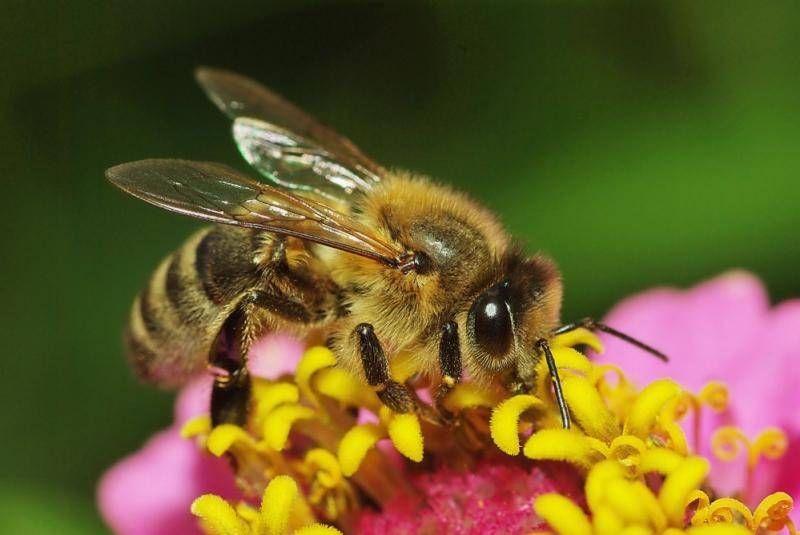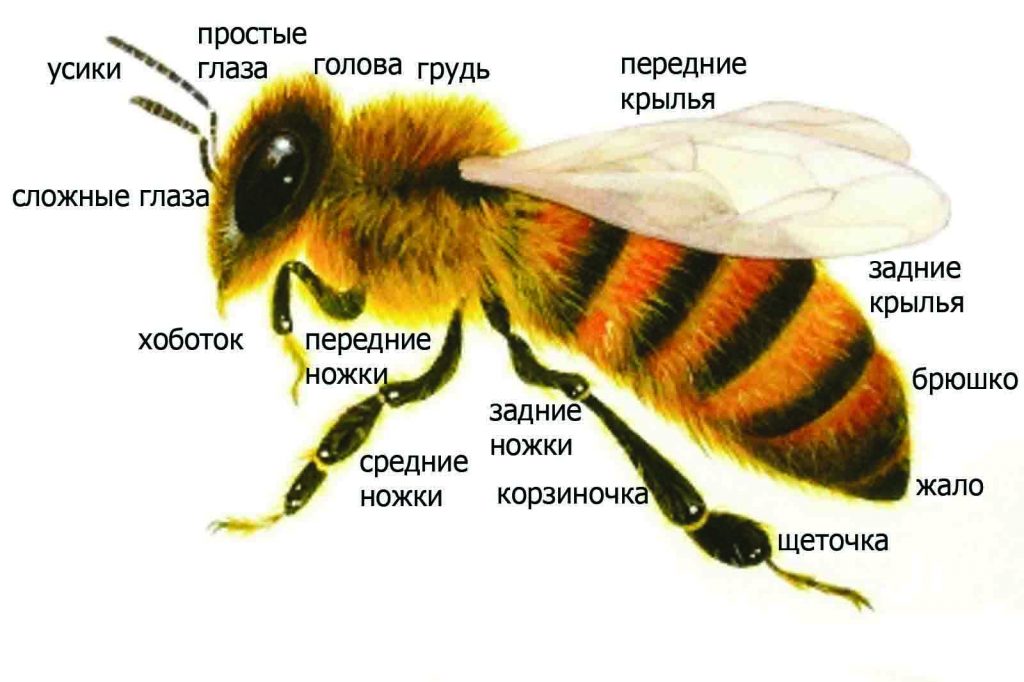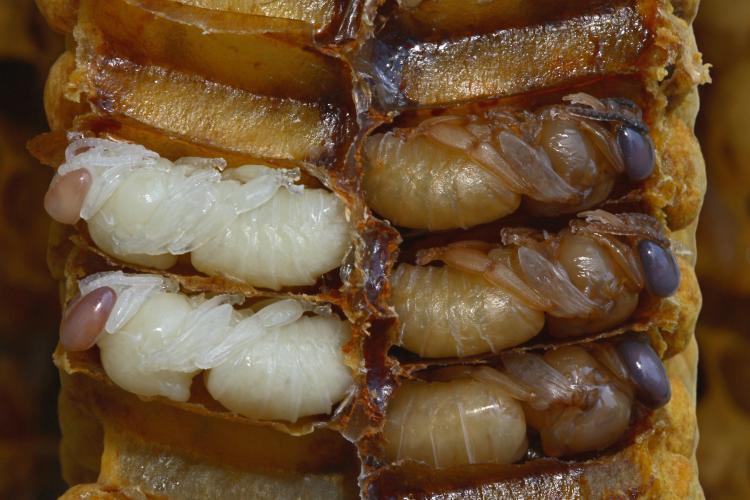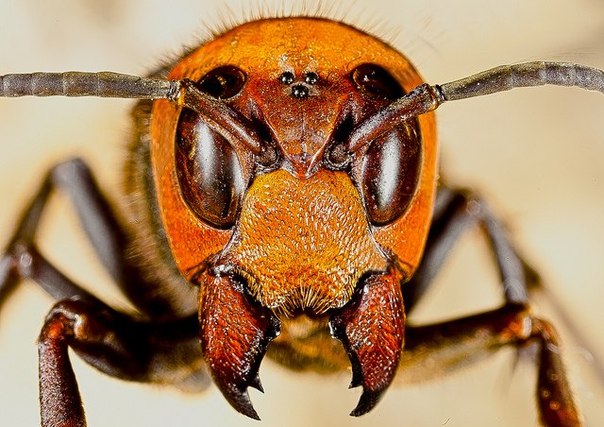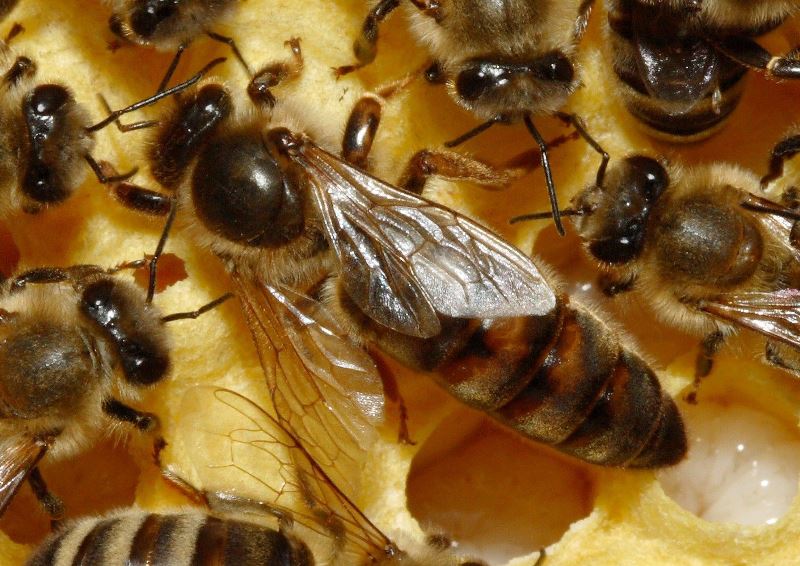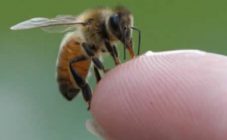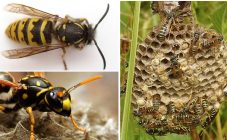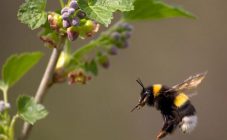Content:
A bee is a flying arthropod insect belonging to the order Hymenoptera, suborder Stem-bellied. Bees are used on the farm solely for the purpose of obtaining honey. To become a real beekeeper, you need to know everything about bees: what a bee looks like, how it works, how it feeds, sees and hears. Knowledge of the anatomy of honey bees will greatly facilitate the work in the apiary and will create the most optimal conditions for insects.
What a bee looks like
Outside, the bee is enveloped by a hard skin - a skeleton, consisting of 3 layers: outer (cuticle), inner (hypodermis) and basement membrane. The outer layer consists of chitin, which protects the entire body from cold, overheating, shock and damage. The body of the bee is covered with fine hairs, which, in turn, are the organs of touch. On the inside of the skeleton there are muscles that provide movement of the individual.
Structure
Outwardly, all bees are practically the same, differ only in the development of individual organs and body parts. The structure of the bee is interesting, or rather the division of its body. All bees, be it a drone, a hard worker or a queen, have three sections: the head, the thoracic region and the abdomen. On the head are the upper lip, upper jaws, a pair of antennae, 2 faceted eyes on the sides and 3 simple ones.
The thoracic region is mainly composed of muscles that provide the insect with movement. The chest consists of 3 rings and 1 segment. Attached to the rings are one pair of legs and one pair of wings.
How many wings do bees have? The insect has 4 of them: a pair of front ones and a pair of back ones. They have a webbed structure, the front ones are more powerful.
How many legs do bees have or how many legs do bees have? Moreover, this is not the same thing, since in this case the foot is the base of the leg. The bee leg consists of five sections:
- thighs;
- swivel;
- hips;
- shins;
- paws.
In total, bees have 3 pairs of legs. At the end of each paw, 2 claws are placed, between which there is a special pad that allows you to move along vertical smooth surfaces.
How many stomachs does a bee have
The digestive system is complex: the mouth, pharynx, esophagus and stomach are supplemented with honey goiter, in which nectar is converted into honey. In some sources, goiter is called the second stomach of a bee.
How much do ordinary bees weigh
The weight of a bee is quite variable, it is determined by some factors: the age of the insect, its fullness with a forage, the contents of the hind gut.
The average bee mass has the following indicators:
- young flying bee - 0.120 g;
- old flying bee - 0.075 g;
- a bee in flight - 0.120 g;
- young bee at the time of departure - 0.122 g;
- uterus in the midst of oviposition - 0.230 g;
- drone - 0.200 g.
All about bees
Bees are highly organized insects, whose lifestyle is unique in its own way. Keeping bees from a beekeeper requires not only basic knowledge about pumping honey and installing a hive, for successful "cooperation" with bees it is necessary to know and take into account many nuances of their bee life.
Interesting facts for beekeepers
Interesting Bee Facts:
- ¾ development of a bee from egg to adult: queen - 17 days, drone - 24 days, worker bees - 21 days;
- ¾ with the help of the upper jaws: the queen - kills rivals, the drone - destroys the sealed cell, providing an exit for itself, worker bees - shape the wax when building honeycombs;
- ¾ a pass to the hive is a specific smell that belongs only to a certain family of bees, they keep the smell in a separate recess in the body, approaching the "watchman" the bee presents this smell as a kind of pass;
- ¾ to get 1 kg of honey, a bee needs to collect nectar from 8-15 million flowers;
- ¾ over the summer, the average family harvests up to 150 kg of honey (420 kg is a record number recorded by honeymen);
- ¾ bees do not sleep in winter;
- ¾ Apis mellifera scutellata bee has the ability to sting repeatedly, while loving to stubbornly pursue the victim;
- ¾ death is possible only from 100-1000 bee stings, directly from the poison, if there is an allergy, a person can die with a single bite;
- ¾ to get a spoonful of honey, 200 individuals must work all day;
- ¾ poppy, lupine, corn, rose hips - make it possible to collect only pollen;
- ¾ About 2 glasses of water are needed by the bee colony per day.
Bee evolutionary history
The evolution of the bee dates back to ancient times. According to paleontological data, bees in their modern form existed on Earth 40 million years ago. The proof is a petrified bee recovered from tertiary sediments in France. Worker bees were found in the Miocene sediments, which are approximately 20-25 million years old. Scientists believe that the history of bees begins over 50 million years.
Scientists entomologists believe that bees are descended from one of the wasp species, which raised its offspring not with animal, but with plant food. In the process of evolution, the internal organs, secretory glands were improved, the most important thing is that the instincts changed, in particular, the hunting ones disappeared, but the skills of collecting nectar and pollen were acquired.
South Asia is considered the homeland of honey bees. Their spread throughout the nearby territory was natural, the only thing - they could not get to the distant USA, Australia, New Zealand from across the ocean, but this problem was easily solved by man.
As these insects see
How do bees see? Real bees have 5 eyes: 3 simple and 2 multi-faceted. Simple ones are located on the back of the head. A multi-faceted eye is a complex organ, consisting of 6,000 independent tiny eyes, it is thanks to these eyes that the bee navigates outside the house, recognizes the places where it is possible to get nectar. With the help of simple eyes, insects navigate inside the hive.
Faceted vision is also called mosaic because the final image the bee gets is formed from separate images from each facet.
Bees are able to see even ultraviolet waves, they see more shades than human eyes. According to some reports, bees do not distinguish red. Insects can only distinguish large objects. A person is able to see things 30 times less than those that a bee can recognize.
Why bees die
In addition to the fact that a bee dies after a human sting, there are many reasons for the degeneration of their population.
The main reasons for the death of bees:
- Ö Neonicotinoids, or new generation pesticides, highly toxic poisons. They are used to process vegetables, vegetable hedges, fields, forests, meadows, and the period of processing just falls on the period of flowering of honey plants.
- Ö Commercial Greed. The pumping of honey in industrial apiaries is carried out almost to zero, for the winter, bees are left without natural feed, which is replaced with sugar syrup. It does not give insects everything they need, as a result they do not tolerate winter well, weaken and reproduce poorly. In advanced cases, entire families die.
- Ö Scarce plant diversity nearby.
- Ö Low resistance to infectious diseases and diseases (the main scourge of insects is varroatosis). The use of antibiotics significantly undermines the immune system of insects.
- Ö Poor apiary care.
Bee family, composition
Honeybees are unique creatures, in the process of evolution they have perfected the skill of effective interaction, organizing numerous families (up to 20 thousand individuals - in winter and up to 120 thousand - during honey collection).
Characteristics of the representatives of the bee family:
- the active part (bee swarm) - worker bees, drones, queen bees;
- passive - combs with brood (bee nest).
Characteristics of bees and their functions
The hierarchy in the bee family is built in the following order:
- uterus;
- drone;
- builders;
- scouts;
- water carriers;
- flying bees;
- receivers;
- security guards.
The queen is the queen of the hive, 2 times the size of an ordinary bee, developing in the queen cell. Manages the whole family using pheromones. She is always in the hive and lays eggs.
The drone is a male representative of the bee family. Its main actions are reduced to fertilization of the uterus and warming of children.
Interesting fact. The drone does practically nothing, but eats 4 times more than a worker bee.
Builders build honeycombs.
The scouts look for where there is nectar, and with the help of dance they report on its quantity and exact location.
Water carriers carry water for the hive from nearby springs.
Flight bees carry pollen and nectar.
The receivers collect the collected nectar from the flight bees and process it.
Guards are individuals who protect the entrance to the hive.
In addition, in the bee family there are: wet-nurses, cleaners, orderlies (they remove corpses), rammers, ventilators, thieves.
Bees are unique creatures that create the most valuable product for humans. Their life is rather short, but the most optimal living conditions can significantly increase this period. Proper care of the hive will allow you to get honey in the maximum possible amount and for a long time.
